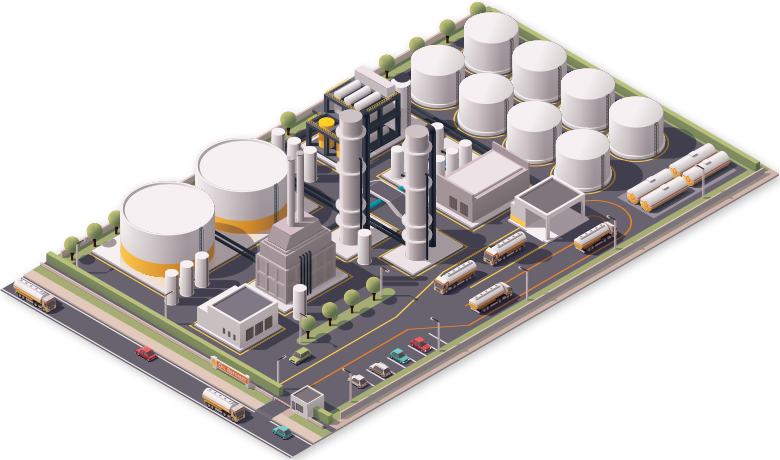Coolant Flowrate
Actual
25m3/hr
Setpoint
25m3/hr

Hello!
We are excited to have you on our career tour. I am Rho, your guide through this wonderful journey.
Supervising involves monitoring plant operations, and analysing
and resolving any issues that may occur to ensure efficient
chemical production.
Let's first understand the basics of supervising a chemical operation



In this tour you will be working at a major fertiliser manufacturing plant.
Fertilisers are used by farmers to supply nutrients to crops which are essential for their growth.



You will supervise a crystallizer in the plant, from control room using computers which receive real-time data from the plant. Control room operators constantly monitor this data and may alert you in case of an issue.


Steps in supervising
Monitor
Monitor parameters (like product temperature, yield) to ensure an
operation is running smoothly
Troubleshoot (if any issue)
Diagnose
Deviation of a parameter from desired value will indicate an issue with the operation, identify cause of the issue
Resolve
Resolve the issue by coordinating with plant teams and changing
operation conditions from control room as required
These are the major steps involved in supervising chemical operations


Assignment
Data From Plant
Crystallizer Solution Temperature
Coolant Flowrate
Actual
25m3/hr
Setpoint
25m3/hr
Warning! None
In control room you will get actual value of crystallizer temperature
every 5 seconds while actual value of coolant flowrate will be updated
every second.
You need to ensure actual crystallizer temperature remains equal to
its ideal value while actual coolant flowrate remains equal to its
setpoint, throughout the operation for proper crystallization.
Note: crystallization is shown to take 100 seconds only for the
purpose of this assignment, actual operation takes much longer
Let’s get to work! Video and guide below will explain how to solve this assignment.
On proceeding you will be taken to your workspace to work on this.


You will now begin supervising the crystallization operation. This assignment has a duration of 100 seconds in which you need to monitor data and troubleshoot any issues that arise.
| Issue | Cause | Remedy |
| Actual coolant flowrate is not equal to setpoint |
Issue in flowrate control instruments |
Ask instrumentation team to look into the issue |
| Actual crystallizer solution temperature is not equal to ideal from the beginning of crystallization operation |
Issue in the operation prior to crystallization |
Change coolant flowrate Allowed coolant flowrates:
21 m3/hr
25 m3/hr
29 m3/hr Higher the coolant flowrate |
*Note : If actual crystallizer solution temperature is equal to ideal keep coolant flowrate at 25 m3/hr
Got it!
Successful Troubleshooting
Unsuccessful Troubleshooting
Improper Troubleshooting
Data From Plant
Crystallizer Solution Temperature
Coolant Flowrate
Actual
25m3/hr
29m3/hr
21m3/hr
Setpoint
25m3/hr
29m3/hr
21m3/hr
Warning! None
Warning!
Actual crystallizer solution temperature is not equal to ideal
Warning!
Actual coolant flowrate is not equal to setpoint
Change coolant flowrate setpoint
21 m3/hr
25 m3/hr
29 m3/hr
Final temperature of crystallizer is within 0.5 °C of ideal, so crystals have formed properly.
You saved the batch inspite of an error from previous operation. Good work!
Final temperature of crystallizer varies from ideal by more than 0.5 °C, so crystals have not formed properly.
The entire batch has been wasted. You should have done better troubleshooting to save the batch.
Final temperature of crystallizer is within 0.5 °C of ideal, so the crystals have formed.
But you changed the coolant flowrate too many times, causing undesirable fluctuations in crystallizer temperature. This has affected the crystal quality.
Final temperature of crystallizer is within 0.5 0C of ideal, so the crystals have formed.
But for some time the difference between ideal and actual causing temperature of crystallizer exceeded 3 0C. This has affected the crystal quality.


Duration of this assignment is over
Change coolant flowrate
Are you sure you want to change the coolant flowrate setpoint?
Cancel
Yes
Change coolant flowrate
Are you sure you want to change the coolant flowrate setpoint?
Cancel
Yes
Change coolant flowrate
Are you sure you want to change the coolant flowrate setpoint?
Cancel
Yes
Send below message to the instrumentation team

“Actual coolant flowrate is not equal to Setpoint.
Could you please check if there is any issue with the flowrate control elements like controller and valve?”
Cancel
Send Message 
Send below message to the instrumentation team

“Actual coolant flowrate is not equal to Setpoint.
Could you please check if there is any issue with the flowrate control elements like controller and valve?”
Cancel
Send Message 
Reply from the instrumentation team

“We found that the Actual coolant flowrate is same as Setpoint.
Please check your plant data again.”
Got It!
Reply from the instrumentation team

“We found that there was an issue with the valve.
It has been solved and the Actual coolant flowrate will become equal to the Setpoint soon”
Got It!
In control room you will get actual value of crystallizer temperature every 5 seconds while actual value of coolant flowrate will be updated every second.
You need to ensure actual crystallizer temperature remains equal to its ideal value while actual coolant flowrate remains equal to its setpoint, throughout the operation for proper crystallization.
Note: crystallization is shown to take 100 seconds only for the purpose of this assignment, actual operation takes much longer
Got it!
| Issue | Cause | Remedy |
| Actual coolant flowrate is not equal to setpoint |
Issue in flowrate control instruments |
Ask instrumentation team to look into the issue |
| Actual crystallizer solution temperature is not equal to ideal from the beginning of crystallization operation |
Issue in the operation prior to crystallization |
Change coolant flowrate Allowed coolant flowrates:
21 m3/hr
25 m3/hr
29 m3/hr Higher the coolant flowrate |
*Note : If actual crystallizer solution temperature is equal to ideal keep coolant flowrate at 25 m3/hr
Got it!

You have reached the end of this tour. Thank you for joining us. We hope to see you again soon!
 Exit Tour
Exit Tour
Are you sure you want to exit this tour?
Cancel
Yes